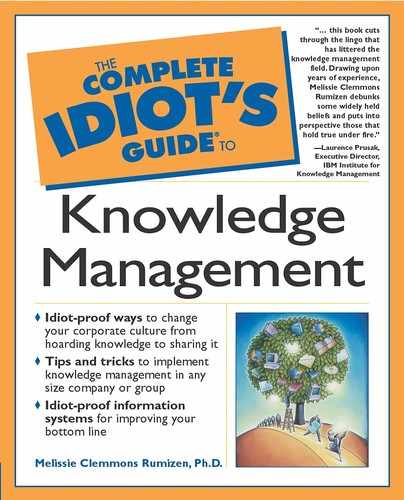Introduction
Decades ago, Peter Drucker began writing about the knowledge worker. Over the last decade, however, more and more attention has been paid to the true engine of today’s organizations: the brainpower of employees.
Saying that is simple, but managing an organization so that it best taps the knowledge of its employees isn’t so simple. For one thing, employees must be given what they need to do a good job: leadership, processes, a supporting organizational culture, information technology, measurement, and leadership. In addition to the leadership of the organization, a new role has emerged in many organizations to lead the knowledge management charge: the Chief Knowledge Officer.
The purpose of this book is to look at the various components needed to manage knowledge in an organization. Doing knowledge management right is much like juggling many balls in the air at the same time. It requires a good bit of skill, not to mention aplomb. But it can be done, and those that do it well see the payoff as they begin to take advantage of the vast store of know-how possessed by employees. This book will help you to learn how to do it.
Part 1, “Exploring the Oxymoron,” gives you the foundation you need to understand knowledge management and what people are doing in the field. It explains the rationale for knowledge management, covers popular theoretical models, gives some basic definitions, and details case studies of two successful knowledge implementations. It also explains the new role in many organizations to lead knowledge management, the Chief Knowledge Officer.
Part 2, “Getting Started,” looks at how to begin implementing knowledge management. This process includes selecting a strategy, a strong suggestion to start with a pilot, and how to build an infrastructure to support the implementation. Several chapters also look at specific approaches to include what I call “the killer application,” communities of practice.
Part 3, “Can’t Live with IT; Can’t Live Without IT,” looks at another critical success factor for knowledge management—information technology. The first chapter explores a critical partner and ally, the Chief Information Officer. Other chapters give some fundamentals such as intranets, collaborative technology, and portals.
Part 4, “The Showstopper of Culture,” looks at what knowledge management tries to change—how “we do things around here.” It also includes several chapters on change management, a discipline for successfully bringing about organizational change.
Part 5, “Keeping Score,” focuses on what is often the Achilles heel of knowledge management—measurement. This part opens with a chapter looking at some general guidelines for measures and then moves to three chapters giving specific methodologies.
Part 6, “Settling In for the Long Haul,” looks at some pitfalls you might encounter along the way and how to scale up. The last chapter looks at personal knowledge management, knowledge management for you on your own.
There’s also a glossary with all of the key definitions in the book.
Special Features
In addition to the regular text, this book contains four extra features designed to help you learn about knowledge management.

Didn’t Know
Didn’t Know boxes give a little more in-depth background. They may be a story, a reference, or some information you might find interesting.

Know Nos
These boxes give you traps to avoid, like common misassumptions and missteps. I’ve made some of these mistakes myself, so I can vouch for them!

Know These
These boxes define terms in more depth than they’re explained in the regular narrative of the chapter. Like any other field, knowledge management has its own jargon. To learn more about the field you need to speak the language.

Know How
Know How boxes give you additional tips that supplement the text. They are meant to be practical and to the point.
Acknowledgments
My thanks to John Woods of CWL Publishing Enterprises, who invited me to write this book and shepherded me through the process. I applaud his editing skills, his knowledge of the field, and his patience. I’d also like to thank Bob Magnan of CWL Publishing Enterprises whose humor and support was helpful.
I am more grateful than I can say to Chuck Seeley of Intel Corporation, who served as my personal technical editor. Chuck is a rare bird, someone who knows a great deal and takes the time to document and share his knowledge. Having Chuck as my technical editor was a constant spur to do my very best. Also thanks to my technical editor for the information technology section, Jeff Stemke, for both his technical expertise and his humor, which I enjoy tremendously and hope one day to understand. And a thank you to Alicia Hill, who provided much needed accounting expertise.
I also owe thanks to many in the knowledge management community. First I must mention Carla O’Dell, Jack Grayson Jr., and the staff and members of the American Productivity and Quality Center. They inspired me to enter this field, and they were also my first teachers.
Finally, I owe thanks to many in the closely-knit and generous knowledge management community. We are all learning together. I’d like to thank those that taught me and directly helped with this book (in alphabetical order):
Verna Allee, the American Red Cross, Bill Baker, Steve Barth, Lucinda Berlew, Mary Bernhard, Susan Biggs, Patrick Bresnan, Mike Burtha, Celemi, Mark Clare, Bill and Laura Clemmons, Don Cohen, Mick Cope, David Coleman, Chris Collison, Rob Cross of University of Virginia, Jane Davis, Steve Denning, The Delphi Group, Arthur Detore, Bill Dietrick, Nancy Dixon, Keith Dompier, Lynette Freese, Carol Gorelick, Kevin Hans, Hewlett-Packard Consulting, Dan Holtshouse, Cindy Hubert, Paula Jacobs, Knowledge Management Review, Knowledge Transformation International, Jerry Landon, Eric Lesser, Marilyn Martiny, Richard McDermott, Jim McKeen, Nick Milton, RS Moorthy, Fred Nickols, Ann Noles, John Old, Geoff Parcell, Peggy Parskey, Larry Prusak, Judi Sandrock, SAP America, Lisa Sasson, John Smith, Dave Snowden, Bill Snyder, Bill Spencer, Sandy Staples, Belinda Stinson, Karl-Erik Sveiby, Erick Thompson, Etienne Wenger, Rowan Wilson, and Tom Young.
Special Thanks to the Technical Reviewer
The Complete Idiot’s Guide to Knowledge Management was reviewed by experts who double-checked the accuracy of what you’ll learn here, to help us ensure that this book gives you everything you need to know about knowledge management. Special thanks are extended to Chuck Seeley, Jeff Stemke, Alicia Hill, and Verna Allee.
Trademarks
All terms mentioned in this book that are known to be or are suspected of being trademarks or service marks have been appropriately capitalized. Alpha Books and Penguin Group (USA) Inc. cannot attest to the accuracy of this information. Use of a term in this book should not be regarded as affecting the validity of any trademark or service mark.
..................Content has been hidden....................
You can't read the all page of ebook, please click here login for view all page.
